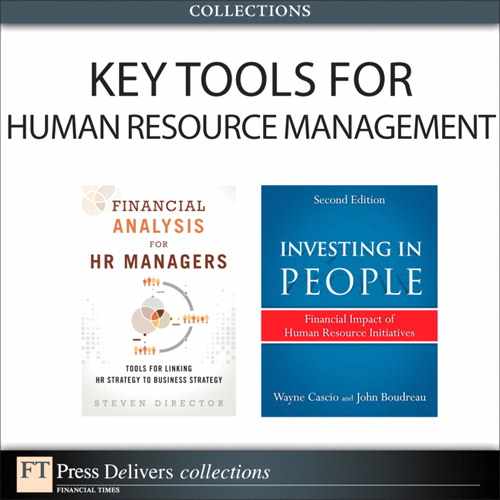Endnotes
Chapter 1
1. Corporate Leadership Council (2008).
2. Mercer Human Resource Consulting (2007).
3. See for an example Schuler and Jackson (2007), Becker, Huselid, and Ulrich (2001), Becker, Huselid and Beatty (2009), and Mercer (2009).
Chapter 2
1. Pfizer, Inc. (2011), page 16.
Chapter 3
1. In addition if a company’s operating cycle is longer than 1 year, an item is considered a current asset if it will be converted to cash or used up within one operating cycle. An operating cycle is the average time required to purchase or manufacture a product, sell it, and collect the cash from that sale, often between 60 and 180 days.
2. The concept and calculation of present value is discussed in detail in Chapter 7.
3. Baker and Alexander (1993).
4. Bloomberg.com (2011).
Chapter 5
1. Becker, Huselid, and Beatty (2009), page 51.
2. Tiffany & Co. (2012), page K3.
Chapter 6
1. Association for Financial Professionals (2011), page 5.
2. Ibid, page 6.
3. The Modigliani-Miller irrelevance proposition tells us that in theory the value the company should not depend on its capital structure. However, in practice not all of the assumptions of the Modigliani-Miller model are met, and empirical research suggests that increasing equity often decreases stock prices while increasing leverage often increases stock prices. See Harris and Raviv (1991).
Chapter 7
1. It is also possible that the cash flow patterns generated by certain projects will produce multiple or no solutions to the IRR equation. See Estrada (2011), pages 268–275.
Chapter 8
1. Cascio and Boudreau (2011), page 229–230. Becker, Huselid, and Ulrich (2001), page 90.
2. This software can be accessed at www.hrcosing.com.
3. Cascio and Boudreau (2011), page 104.
Chapter 9
1. Association for Financial Professionals (2011), page 4.
2. Ibid.
3. Ibid, page 6.
4. Rehm and Silvertsen (2010).
Chapter 10
2. Frederic W. Cook & Co. (2004), page 4.
3. Frederic W. Cook & Co. (2004), page 4. Frederic W. Cook & Co. (2008), page 5. Frederic W. Cook & Co. (2011), page 7.
4. FASB ASC 718 (formerly, FASB Statement 123R). See Bragg (2011), pages 994–1014.
5. Kieso, Weygandt, and Warfield (2012), p.919.
7. Forbes.com (2001).
Chapter 11
1. U.S. Federal Reserve System (2012).
2. U.S. Office of Management and Budget (2012).
3. Alcoa 2011 Annual report, page 137.
4. Lockheed Martin Corporation (2012).
10. Benartzi and Thaler (2001).
12. Edmiston, Gillett-Fisher, and McGrath (2009).
Chapter 12
1. Center on Executive Compensation (2012a).
5. Stern, Stewart, and Chew (1999).
6. Kaiser Aluminum Corp (2011).
9. Damodaran, (2011), page 311.
10. As discussed in Chapter 7, IRR measures make a reinvestment rate assumption that may not always be appropriate. A modification of the basic CFROI approach adopted by some firms involves adjusting the gross cash flow estimates downward by subtracting the amount that would have to be set aside replace these assets at the end of their projected life. That variation assumes that instead of being continually reinvested at the CFROI rate, at least a portion of the cash flows will be reinvested at the lower WACC rate. Calculations based on lower cash flows, of course, lead to lower estimates CFROI. See Damodaran (2012), page 885.
12. Operating cash flow = net income + Depreciation and Amortization + after-tax interest expense + rental expense under operating leases + R&D expense + or – nonrecurring items. Invested capital = total assets + accumulated depreciation + asset inflation adjustment + Capitalized operating leases+ Capitalized R&D – nondebt current liabilities. Adding depreciation and amortization back to net income converts it from a profit measure to a cash flow measure. Removing nonrecurring, one-time expenditures is intended to produce a better estimate of ongoing cash flows generated by these investments. The rental and R&D costs that were subtracted out when net income was calculated are added back because they are viewed as investments rather than as current expenses. The capitalized R&D and lease expenses are then added to the denominator.
14. General Electric (2012), page 18.
16. Koller, Dobbs, and Huyett (2011) page 5.
18. Center on Executive Compensation (2012b).
20. U.S. Securities and Exchange Commission (2009).
